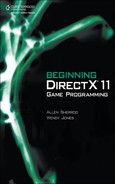Many of us wish to create our own video games. For some, gaming is a hobby, and for others it is something fun to participate in casually. But for the rest of us, gaming and the dream of making our own games is more like a passion. Chances are, if you’ve purchased this book, you are looking to turn your desire and passion into something you can play and share with others.
This book is the follow-up edition to Wendy Jones’s Beginning DirectX 10 Game Programming book. In this book, we teach you the basics of getting started with game graphics using the latest iteration of Direct3D: Direct3D 11.
The goal of this book is to teach you the various aspects of DirectX 11. The target audience for this text is beginning/intermediate C++ programmers with little to no experience with DirectX. Although past DirectX or OpenGL experience can be useful, it is not required.
When you reach the end of this book, you will have had enough experience with DirectX 11 that you should be able to explore making simple video games and demos. Ideally, you will work your way up to make complex games and demos until you find yourself able to complete and release (even if for free at first) your own PC games.
This book assumes you have knowledge and familiarity of the C++ programming language. You are also assumed to have a comfortable working knowledge of Visual Studio 2010 and have completed at least a high-school level of mathematics. Since this book is centered on learning DirectX for the first time, knowing DirectX is, of course, not required for working through this book.
Throughout this book we use Visual Studio C++ 2010 Express, which can be downloaded from Microsoft’s website at www.microsoft.com/express/Downloads. We are also using the June 2010 DirectX SDK, which can be downloaded from http://msdn.microsoft.com/en-us/directx.
Although not required for this book, it is recommended to try Adobe Photoshop for the creation of textures (www.adobe.com/products/photoshop/photo-shopextended/) and XSI Mod Tool 7.5 for the creation of 3D models and meshes (http://usa.autodesk.com).
Almost every chapter has code samples and demos that give you hands-on exercises of the topics discussed. To follow along, view, execute, or manipulate these code samples, you will need the book’s accompanying code, which can be downloaded from:
www.ultimategameprogramming.com/BeginningDirectX11/
or
At either of these locations, you’ll also find Web-only bonus content, including a ninth chapter, “Conclusions,” Appendix A, “Chapter Answers” (which provides answers to all the end-of-chapter review questions), and Appendix B, “Audio in DirectX” (which introduces you to the various DirectX APIs, including XAudio2 and XACT3).
Sometimes there are errors that are not caught before the book is released or that can even arise due to outside circumstances that we could not anticipate. If you find any errors or issues with the book, please be sure to submit them to the companion website at www.ultimategameprogramming.com/BeginningDX11. Also be sure to check the companion website to see if there are existing issues that other readers have found that you might find useful to know.
You may download the companion Web site files from www.courseptr.com/ downloads. Please note that you will be redirected to our Cengage Learning site.
